A view of destruction after the US warplanes carried out an airstrike on the headquarters of Hashd al-Shaabi in Al-Qa’im city of Anbar, Iraq on February 03, 2024.
Hashd al-Shaabi Media Office | Anadolu | Getty Images
The United States launched airstrikes in Iraq and Syria against more than 85 targets linked to Iran’s Revolutionary Guard (IRGC) and the militias it backs, reportedly killing more than 30 people, in retaliation for a deadly attack on U.S. troops.
The strikes, which included the use of long-range B-1 bombers flown from the United States, were the first in a multi-tiered response by President Joe Biden’s administration to the attack last weekend by Iran-backed militants.
More U.S. military operations were expected in the coming days.
The strikes intensified a conflict that has spread into the region since war erupted between Israel and Hamas after the militant Palestinian group’s deadly assault on Israel on Oct.7.
Iran’s foreign ministry spokesperson Nasser Kanaani said in a statement the U.S. attacks represented “another adventurous and strategic mistake by the United States that will result only in increased tension in instability in the region”.
Iraq also condemned the U.S. attacks, saying they had killed 16 people including civilians. In Syria, the strikes killed 23 people who had been guarding the targeted locations, said Rami Abdulrahman, director of the Syrian
Observatory for Human Rights, an organization that reports on war in Syria.
Joint Chiefs of Staff Director for Operations Lt. Gen. Douglas A. Sims II arrives to brief members of the House of Representatives in a classified, closed-door briefing about Hamas’ attack on Israel in the Capitol Visitors Center Auditorium on October 11, 2023 in Washington, DC.
Chip Somodevilla | Getty Images News | Getty Images
U.S. Lieutenant General Douglas Sims, the director of the Joint Staff, said the attacks appeared to be successful, triggering large secondary explosions as the bombs hit militant weaponry. He said the strikes were undertaken knowing that there would likely be casualties among those in the facilities.
Despite the strikes, the Pentagon has said it does not want war with Iran and does not believe Tehran wants war either, even as Republican pressure has increased on the Biden to deal a blow directly.
Iran, a backer of Hamas, has sought to stay out of the regional conflict itself even as it supports groups that have entered the fray from Lebanon, Yemen, Iraq and Syria – the so-called “Axis of Resistance” that is hostile to Israeli and U.S. interests.
‘We do not seek conflict’
U.S. Defense Secretary Lloyd Austin said after the strikes that Biden had directed additional action against the IRGC and those linked to it. “This is the start of our response,” Austin said.
“We do not seek conflict in the Middle East or anywhere else, but the president and I will not tolerate attacks on American forces,” Austin said.
A view of destruction after the US warplanes carried out an airstrike on the headquarters of Hashd al-Shaabi in Al-Qa’im city of Anbar, Iraq on February 03, 2024.
Hashd al-Shaabi Media Office | Anadolu | Getty Images
An Iraqi government statement said the areas bombed by U.S. aircraft included places where Iraqi security forces are stationed near civilian locations. It said 23 people had been wounded in addition to the 16 killed.
The White House said the United States had informed Iraq ahead of strikes. Baghdad later accused the United States of deception, saying a U.S. claim of coordination with the Iraqi authorities was “unfounded”.
The Syrian foreign ministry said the United States was fueling conflict in the region in a “very dangerous way”.
On Friday, Iran’s President Ebrahim Raisi said his country will not start a war, but it will “respond strongly” to anyone who bullies it.
Hamas condemned the U.S. strikes and said Washington was pouring “oil on the fire”.
Britain called the United States its “steadfast” ally and said it supports Washington’s right to respond to attacks.
Polish Foreign Minister Radek Sikorski, arriving for an EU meeting in Brussels, said the U.S. strikes were the result of Iranian proxies “playing with fire”.
More than 160 attacks on U.S. troops
The strikes hit targets including command and control centers, rockets, missiles and drone storage facilities, as well as logistics and munition supply chain facilities, the U.S. military said in a statement.
In Iraq, local residents said several strikes hit the Sikak Neighborhood in Al-Qaim, a residential area that locals said was also used by armed groups to store large amounts of weapons. Militants had left the area and gone into hiding in the days since the Jordan attack, local sources said.
A view of destruction after the US warplanes carried out an airstrike on the headquarters of Hashd al-Shaabi in Al-Qa’im city of Anbar, Iraq on February 03, 2024.
Hashd al-Shaabi Media Office | Anadolu | Getty Images
U.S. troops have been attacked over 160 times in Iraq, Syria and Jordan since Oct. 7, usually with a mix of rockets and one-way attack drones, prompting the United States to mount several retaliatory attacks even before the latest strikes.
The United States has assessed that the drone that killed the three soldiers and wounded more than 40 other people in Jordan was made by Iran, U.S. officials have told Reuters.
“Our response began today. It will continue at times and places of our choosing,” Biden said.
The top Republican on the Senate Armed Services Committee, Roger Wicker, criticized Biden for failing to impose a high enough cost on Iran, and taking too long to respond.
Iranian advisers assist armed groups in both Iraq, where the United States has around 2,500 troops, and Syria, where it has 900.


